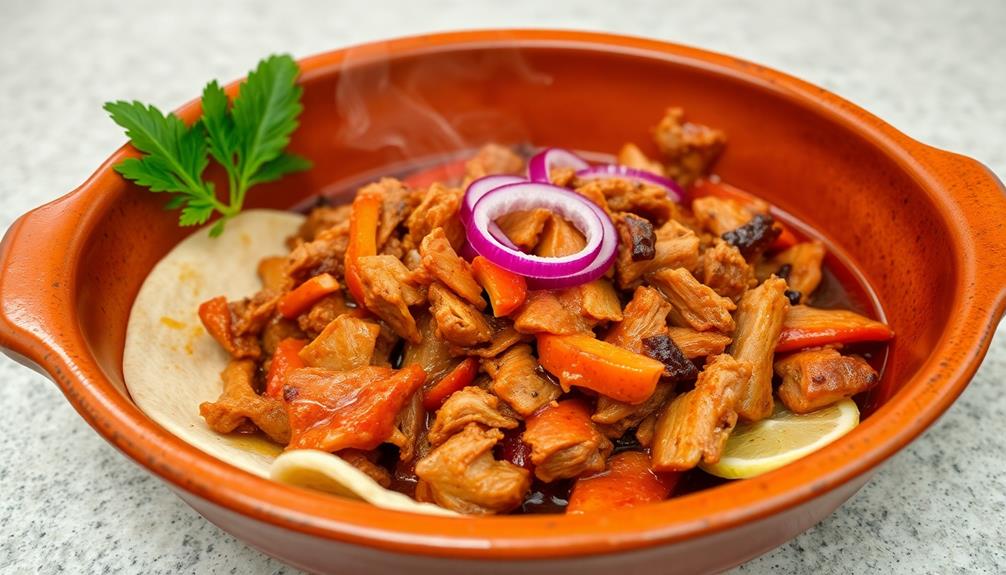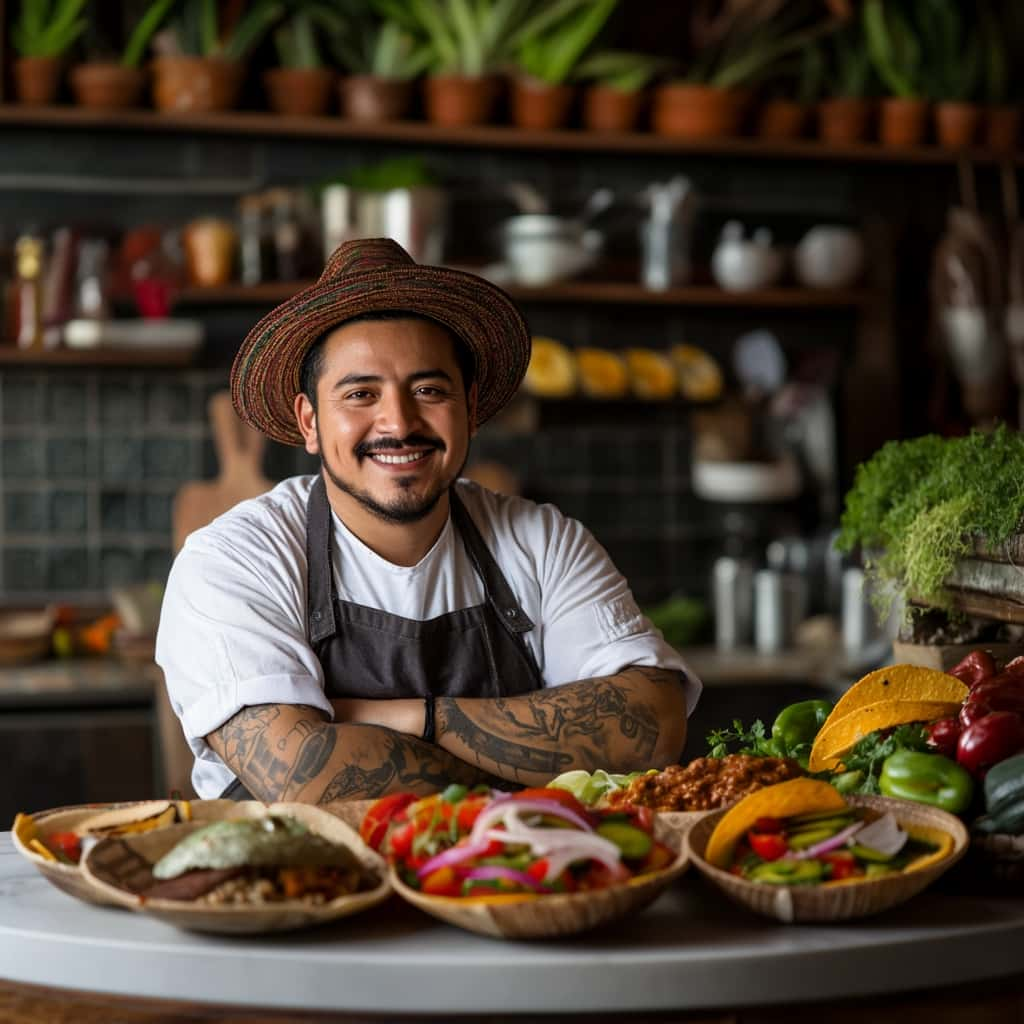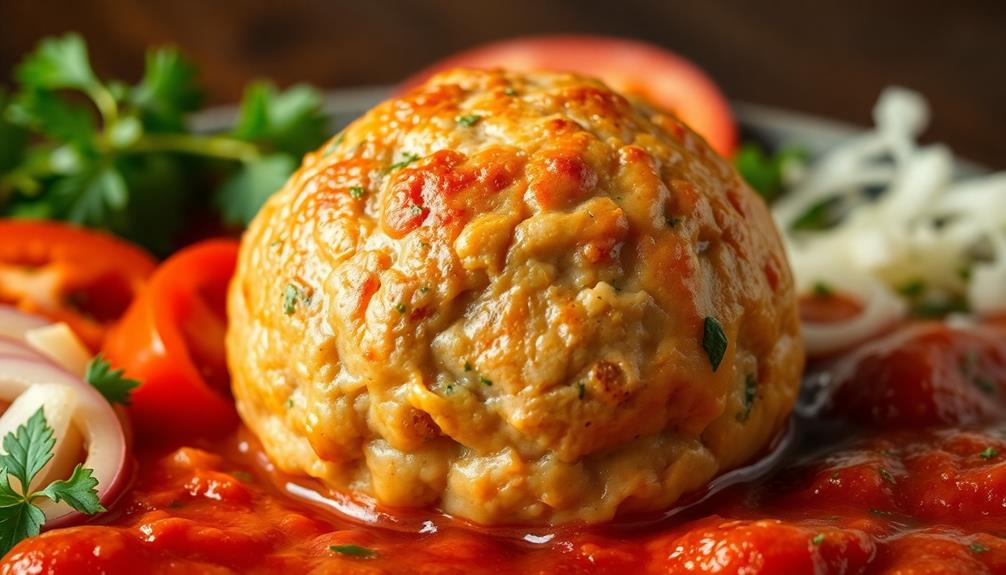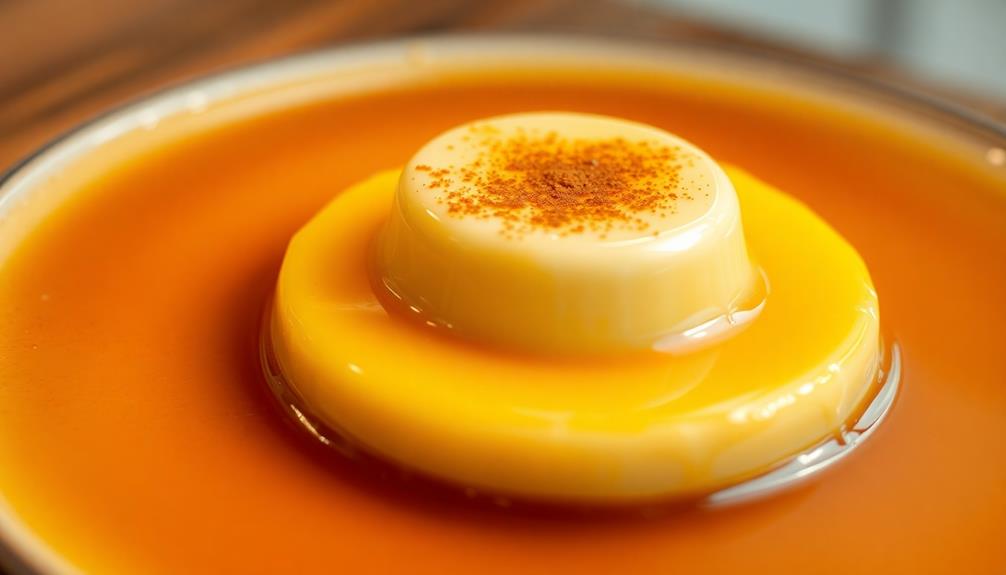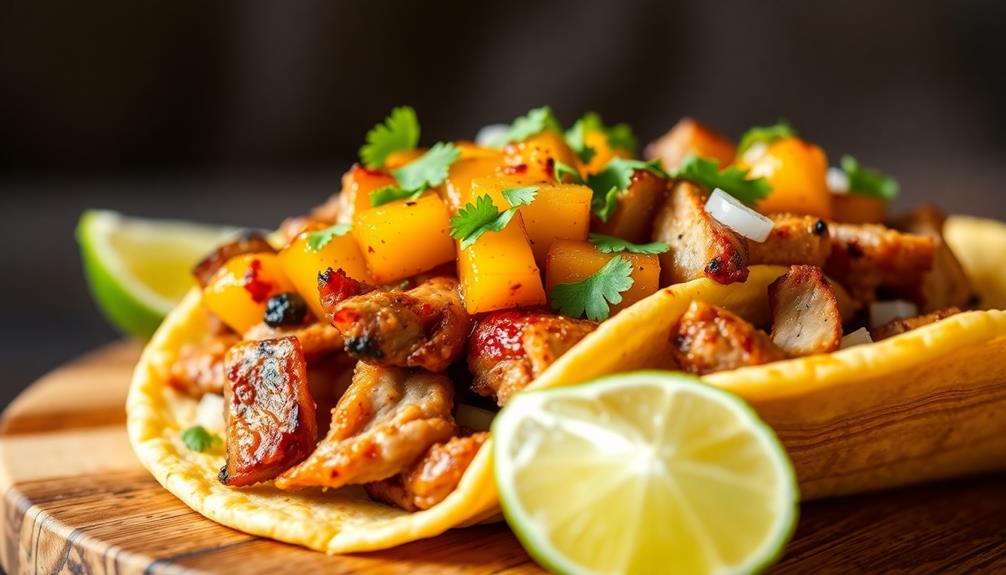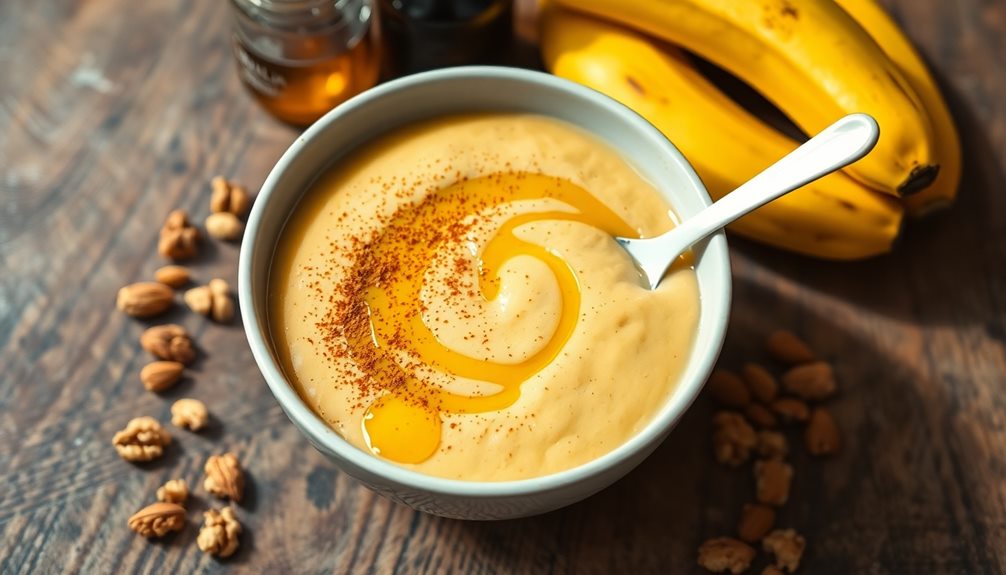Cochinita pibil is a truly mouthwatering and slow-roasted pork dish that's been enjoyed for centuries in the Yucatán Peninsula of Mexico. It's made by marinating tender pork in a mixture of achiote paste, citrus juices, and spices, then wrapping it in banana leaves and slow-cooking it until it's fall-off-the-bone tender. The result is a dish with a smoky, earthy flavor and a lovely, vibrant color. Top it with tangy pickled onions, fresh tortillas, and lime wedges for a truly authentic and delicious taste of Yucatecan cuisine. There's so much more to discover about this beloved dish!
Key Takeaways
- Cochinita Pibil is a traditional slow-roasted pork dish from the Yucatán Peninsula, Mexico, with roots in ancient Mayan cooking methods and Aztec culinary influences.
- The dish is known for its rich, smoky, and tangy flavor profile, achieved through the use of achiote paste, citrus juices, and spices like cumin and oregano.
- The pork is marinated, wrapped in banana leaves, and slow-cooked to achieve a tender, juicy texture, with the banana leaves imparting a delicate, earthy flavor.
- Pickled onions and fresh tortillas are commonly served as accompaniments, providing a tangy contrast and a classic presentation for the dish.
- Cochinita Pibil is an integral part of Yucatecan cuisine, celebrated during special occasions and family gatherings, and represents a fusion of Mayan and Spanish culinary influences.
History
Cochinita pibil is a traditional slow-roasted pork dish from the Yucatán peninsula in Mexico. The history of this delectable dish can be traced back to the ancient Mayan civilization.
The Mayans would bury meat in pits, called "pibil," and slow-cook it over hot rocks and leaves, creating a tender and flavorful result. Over time, the recipe evolved, and the Spaniards who arrived in the 16th century added their own twist, incorporating achiote paste, citrus juices, and other spices.
Today, cochinita pibil is a beloved part of Yucatecan cuisine, enjoyed by locals and visitors alike. The slow-cooking process tenderizes the pork, infusing it with the rich, earthy flavors of the achiote, while the citrus adds a bright, tangy note. This traditional Yucatecan dish is often served with pickled onions and a side of refried beans, creating a perfect balance of flavors and textures. The dish has a long history in the Yucatan region, with its roots in Mayan cuisine and cooking techniques. Its enduring popularity is a testament to the delicious combination of flavors and the skillful preparation required to achieve the perfect cochinita pibil.
Whether you're exploring the vibrant markets of Mérida or relaxing on the beaches of Tulum, be sure to try this iconic Mexican dish – it's a delicious window into the region's rich culinary heritage.
Recipe
Cochinita Pibil is a slow-roasted pork dish that originated in the Yucatán Peninsula of Mexico. The pork is marinated in a savory and tangy achiote-citrus sauce, then wrapped in banana leaves and cooked until tender and flavorful. This dish is a beloved classic in Mexican cuisine, often served with warm tortillas, pickled red onions, and other accompaniments.
The long, slow cooking process is what gives Cochinita Pibil its signature melt-in-your-mouth texture and deep, complex flavors. The achiote paste, made from annatto seeds, provides a vibrant orange-red color and earthy, slightly peppery taste, while the citrus juices lend a bright, tangy note to balance the richness of the pork.
Ingredients:
- 3-4 lbs pork shoulder, cut into large chunks
- 1 cup achiote paste
- 1 cup orange juice
- 1/2 cup lime juice
- 4 cloves garlic, minced
- 2 teaspoons dried oregano
- 1 teaspoon ground cumin
- 1 teaspoon salt
- 1/2 teaspoon black pepper
- Banana leaves, for wrapping
To prepare, combine the achiote paste, orange juice, lime juice, garlic, oregano, cumin, salt, and pepper in a large bowl. Add the pork chunks and toss to coat evenly. Cover and marinate in the refrigerator for at least 4 hours, or up to 24 hours.
Preheat your oven to 325°F (165°C). Lay the banana leaves in an overlapping pattern on a large baking sheet or in a roasting pan. Place the marinated pork chunks in the center, then wrap and seal the banana leaves around the pork. Bake for 3-4 hours, or until the pork is very tender and falls apart easily.
When ready to serve, unwrap the pork and shred it with two forks. Serve the Cochinita Pibil with warm tortillas, pickled red onions, fresh cilantro, and any other desired toppings or accompaniments. The slow-cooked pork is incredibly flavorful and pairs perfectly with the tangy, crunchy garnishes.
Cooking Steps
First, you'll rub the pork with a zesty spice mixture.
Then, you'll wrap the pork in fragrant banana leaves before cooking it to perfection.
Step 1. Rub Pork With Spice Mixture
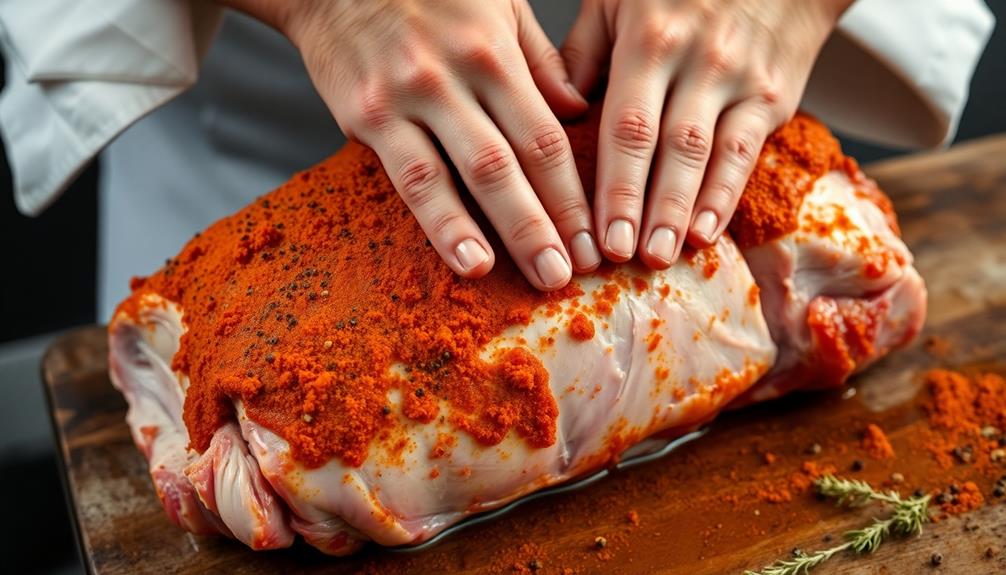
After preparing the spice mixture, generously rub it all over the pork. Don't be shy – you want to make sure every inch of the meat is coated in that delicious blend of flavors!
Imagine how amazing it's going to smell as the pork roasts in the oven. The aroma of the warm spices, the citrusy kick of the orange juice, and the earthy notes of the cumin will make your mouth water.
Once the pork is fully seasoned, place it in a baking dish or roasting pan. The spices will create a beautiful, reddish-brown crust as the meat cooks, locking in all that juicy goodness.
As the pork sizzles away, your kitchen will transform into the most tantalizing of kitchens. You'll be tempted to peek at it every few minutes, but try to resist – good things come to those who wait!
Just let the flavors meld together and create a truly unforgettable dish.
Step 2. Wrap Pork in Banana Leaves
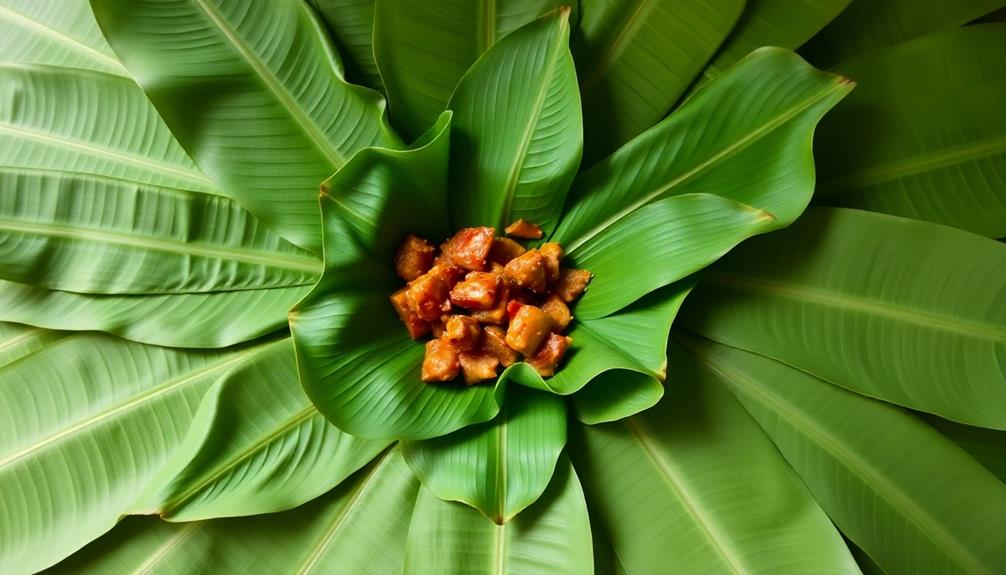
Once the pork is generously rubbed with the spice mixture, it's time to wrap it in banana leaves.
First, get some wide, fresh banana leaves. Gently lay the leaves shiny-side down on your work surface. Place the seasoned pork in the center of the leaves. Carefully fold the long sides of the leaves over the pork, then fold the shorter ends over to completely enclose it. Tie the bundle up tightly with kitchen string to keep the leaves in place.
This cozy banana leaf wrap locks in all the savory flavors as the pork slow-cooks. The leaves also add a lovely, delicate tropical aroma.
When you unwrap the pork, you'll find it's tender, juicy, and infused with the vibrant spices. Serve the cochinita pibil with warm tortillas, citrusy onion relish, and plenty of fresh cilantro.
It's a mouthwatering feast that'll have everyone reaching for seconds!
Step 3. Cook Pork in Banana Leaves
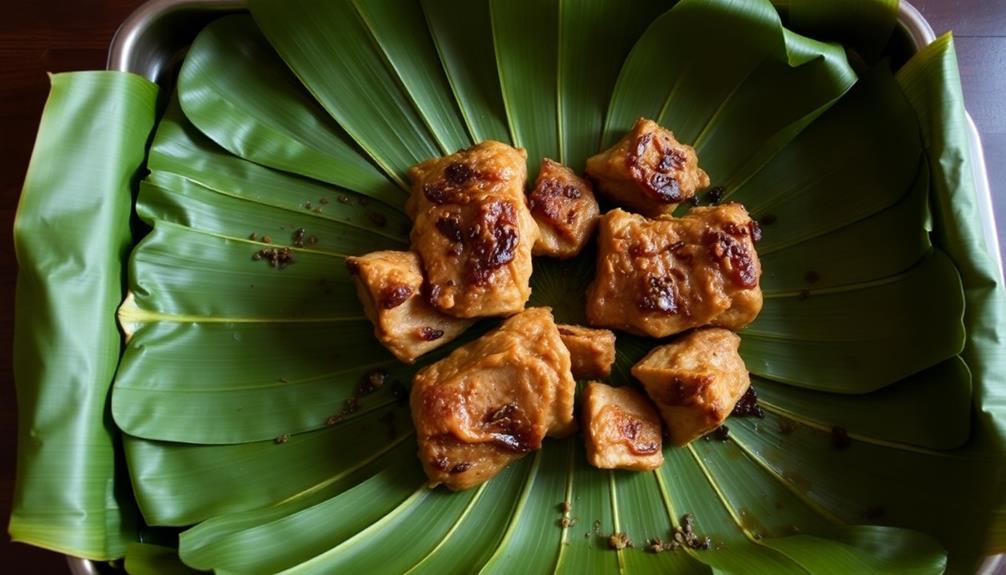
With the pork securely wrapped in the banana leaves, you can now begin the slow-cooking process.
Place the wrapped pork into a large pot or Dutch oven, and add just enough water to cover the package. Bring the water to a gentle boil, then reduce the heat to low, ensuring a steady simmer. Let the pork cook for about 2-3 hours, until the meat is incredibly tender and practically falling apart.
As the pork simmers, your kitchen will fill with the most mouthwatering aromas. The banana leaves will infuse the meat with a delicate, earthy flavor that's simply divine.
You'll know the pork is ready when you can easily pierce it with a fork. Carefully remove the package from the pot and let it rest for a few minutes before unwrapping.
The succulent, shredded pork is now ready to be enjoyed in all sorts of delicious Cochinita Pibil dishes!
Step 4. Remove Cooked Pork
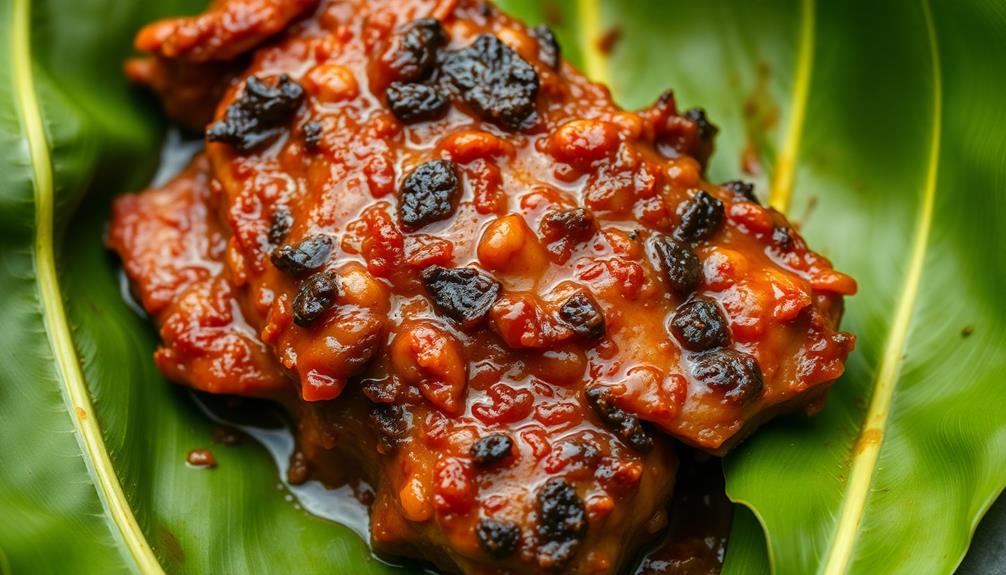
Carefully unwrapping the tender, fall-apart pork from the banana leaves, you'll reveal the most succulent and fragrant meat. The aroma will fill the air, making your mouth water in anticipation.
Gently remove the pork, taking care not to let any of the precious juices escape. The meat should practically fall off the bone, so delicate and moist from its long, slow cooking.
Shred the pork with two forks, creating luscious, bite-sized pieces. Make sure to incorporate all the flavorful bits and juices that have collected in the banana leaves. This is the best part – the pork is infused with the earthy, aromatic flavors of the marinade and the banana leaves, creating a truly exceptional taste.
Now you're ready to assemble your Cochinita Pibil tacos or serve the pork as the star of the dish. Get ready for your family and friends to be wowed by the incredible tenderness and depth of flavor in every bite!
Step 5. Serve Pork With Pickled Onions

To complement the tender, flavorful pork, you'll want to prepare a batch of refreshing pickled onions. This quick and easy condiment adds a tangy zing that perfectly balances the richness of the cochinita pibil.
Start by thinly slicing a red onion. Place the onion slices in a glass jar or bowl. In a small saucepan, combine white vinegar, water, a pinch of salt, and a touch of sugar. Bring the mixture to a boil, then pour it over the onions. Make sure the onions are completely submerged.
Let the pickled onions cool to room temperature, then cover and refrigerate for at least 30 minutes, or up to a week. The longer they sit, the more flavorful they'll become.
When ready to serve, simply drain the onions and arrange them on a plate alongside the succulent cochinita pibil. The cool, acidic crunch of the pickled onions is a delightful contrast to the slow-roasted pork.
Final Thoughts
Cochinilla pibil is a delicious and authentically Mexican dish that's well worth the time and effort required to prepare it.
You'll be amazed at the complex flavors that emerge from this simple recipe. The tender, juicy pork is perfectly complemented by the tangy pickled onions, creating a harmony of tastes that will have your taste buds dancing.
As you savor each bite, you'll be transported to the vibrant streets of Mexico, where the aroma of this beloved dish fills the air.
The vibrant hues of the pork and the brilliant pink of the pickled onions make for a truly eye-catching presentation that will impress your family and friends.
Frequently Asked Questions
How Long Does It Take to Marinate the Pork?
To marinate the pork, you'll need to let it sit for at least 6 hours, though overnight is best. The longer the marinating time, the more flavorful the meat will be.
Can I Use a Slow Cooker Instead of an Oven?
Yes, you can use a slow cooker instead of an oven. The slow cooking process will allow the flavors to meld and the meat to become tender. Just be sure to adjust the cooking time accordingly.
What Is the Best Type of Banana Leaf to Use?
When using banana leaves, opt for fresh, pliable ones. They'll provide the best flavor and texture for your dish. Avoid dried or wilted leaves, as they may not seal the cooking vessel properly.
Can I Substitute the Achiote Paste With Paprika?
You can substitute the achiote paste with paprika, but the flavor profile won't be quite the same. Paprika won't provide the distinct reddish hue or earthy, slightly peppery taste that achiote paste delivers.
How Long Does the Cooked Pork Last in the Fridge?
The cooked pork should last in the fridge for about 3-4 days. Make sure to store it in an airtight container and consume it within that time frame for best quality and food safety.
